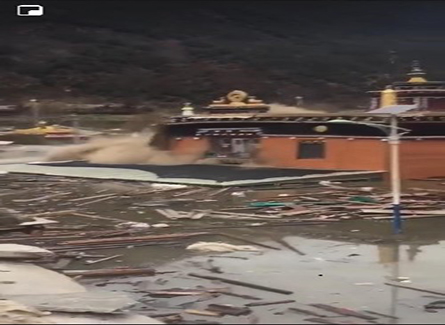Recent landslides on the banks of the Drichu River*in Chamdo city in Jomda, Dzogang County in the Tibetan Autonomous Regions (TAR) have been causing major disruption for Tibetans inhabiting the area. Several protests and reports hold heavy mining by the Chinese government responsible for these environmental disasters.
A barrier lake has formed as a result of a landslide on the banks of the Drichu River on November 3. This is the second landslide in the same area of the intersection between Phayul, Bhutang and Derong Counties. The first landslide in October had also created a dam in the same river forcing the local Tibetans to move to higher regions in case of flooding.

Monastery submerged by the river
The water levels are reported to be still rising rapidly, submerging many two storey dwellings in Polu Township. A 900-year-old monastery in Polu has also been affected by the rising water levels. “The Polu Monastery in Chamdo’s Jomda district is now mostly under water, with many of the monastery’s religious artefacts now ruined beyond repair”, reported a local source to Radio Free Asia’s Tibetan Service.
A state of emergency has been declared which has affected over 30,000 residents. Freetibet.org reported that the areas affected include townships in Drichu County, Ganzi, Polu and Chamdo city.
The local Tibetan communities have organised protests against the Chinese mining activities in the past, all of which are reported by Tibet Watch in their 2015 report Environmental Protests on the Tibetan Plateau, Thematic Report. The section which looks at Dzogang County reports on an anti-mining protest which took place in April 2014 against the large-scale mining activities along the Drichu river. The copper-rich area has China’s second largest copper mine – Yulong Copper Mine. The Tibet Watch report gives details of a self-immolation protest that took place there: “A 39-year-old man named Phakpa Gyaltsen, took his own life in protest at the continued mining activity. He was from Kebar village in Tongbar township, Dzogang County. He jumped to his death off a local school building and died at the scene […] shouting ‘We Tibetans don’t have freedom, Tibet needs independence, let Gyalwa Rinpoche [the Dalai Lama] return to Tibet’.” Another anti-mining protest took place in October 2013 in nearby Lhagang township and sporadic protests occur across eastern Tibet.
The report states, “Chinese companies have traditionally mined on a small scale but now large-scale extractions are taking place, mainly by large companies which are owned by, or have close links to, the state. Most workers in Tibetan mines are Chinese and the extraction takes place without regard to the local environment and areas of religious or cultural significance.”
- The Drichu River, known in Chinese as the Jinsha River, forms part of the head water system for the Yangze River – the longest river in Asia – which meets the sea at Shanghai in China.




 Print
Print Email
Email